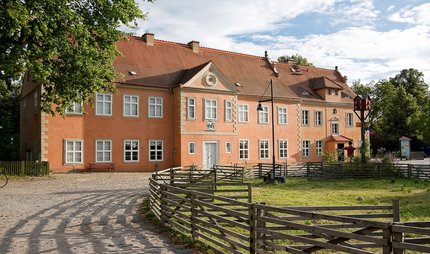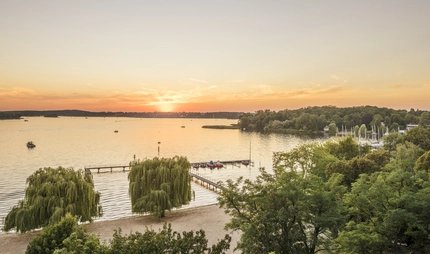
Museumsdorf Düppel | Stadtmuseum Berlin
Travel 800 years into the past
In 1975, the Museumsdorf Düppel opens its doors for the first time. Find out how people and animals lived 800 years ago. The village is a representation of medieval life in a typical German town or village during the 13th century. This unique open air museum also caters to those with an interest in archaeology. Members of the society for the promotion of the museum test medieval techniques and equipment here, making research tangible and relevant.
Medieval houses, workshops and animals
Archaeological investigations begin in the area in 1967, and they soon find signs of a settlement. In 1975, a recreation of the village is built on the original foundations to create the living museum. The buildings are constructed using medieval tools and techniques. Take a journey into rural life in the Middle Ages. Behind a high oak palisade, thatched wooden houses are arranged around the horseshoe shaped village green. There are no windows, and some roofs reach all the way to the ground. Smell the tar and charcoal in the air. Learn about the physical nature of medieval farming and see an old plough. Everything is reconstructed exactly as it was; the bakery with its bread oven, the blacksmith, pottery and the grain store are exactly as they would have been. The village is surrounded by forests, meadows and pastures with sheep, oxen and goats. The willow meadows have been allowed to regrow. Skudden sheep, typical of the Middle Ages, can be seen here too. In the orchards, the trees are full of apples, quince and plums - all traditional species. Take a break in a rustic tavern serving snacks and drinks. The museum also hosts special markets and events, including fairytale themed events for children in April.
What to see in the open air museum
- Medieval houses with authentic decor.
- Historic workshops and equipment.
- A reconstructed well.
- Fields and gardens with medieval crops, medicinal plants and plants for dye.
- Reclaimed willow plants and the endangered Skudden sheep.
Green oases in the middle of Berlin
Another of Berlin's open-air museums is the Domain Dahlem, an open-air agricultural and nutritional museum a few kilometres north of Museumsdorf Düppel. This area has been cultivated for over 800 years, and you can see a traditional manor house, merchant's shop and a 1920s butcher. Visit the Culinarium for a short presentation about our eating habits. In the centre of the old town, you'll find the Lübars Reinickendorf district. This is the oldest part of Berlin, first mentioned in 1247. Visit the family farm and see the farmers growing crops and foraging. On the Märkischen Bauernhof, children can learn how to make bread, butter or to spin wool. Adults can try pottery or silk and glass painting.
Information about Museumsdorf Düppel
The Museumsdorf Düppel is 15 minutes from the Zehlendorf S-Bahn station. Alternatively, use buses 115, 118 or 622; the bus station is just a few minutes from the open air museum. People under the age of 18 get free admission, as do Museumspass Berlin holders. The museum is open weekends and during holiday periods. Special events and tours on topics such as pottery, foraging or spinning can be arranged in advance for groups.
Information for families and children
On Sunday and bank holidays there are free guided tours from 11am. Children can learn about everyday life in the Middle Ages. See how tar is formed from wood by heating the resin and extracting the liquid. There are also medieval children's games held in the village square.



